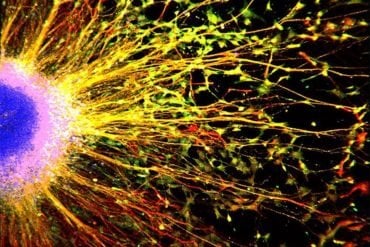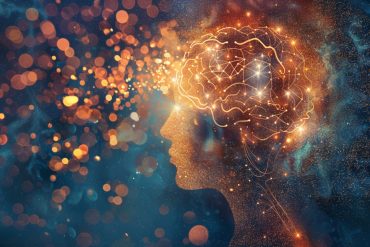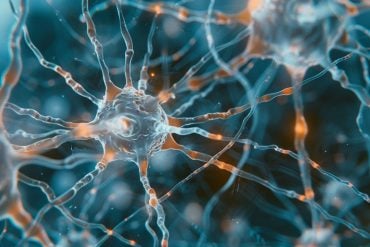Summary: The brain adjusts the attention it gives to identical sounds the moment they are perceived in the brainstem.
Source: University of Geneva
Our sound environment is extremely dense, which is why the brain has to adapt and implement filtering mechanisms that allow it to hold its attention on the most important elements and save energy. When two identical sounds are repeated quickly, one of these filters – called auditory sensory gating – drastically reduces the attention that the brain directs to the second sound it hears. In people with schizophrenia, this ability to reduce the brain’s response to identical sounds does not function properly. The brain, it seems, is constantly assailed by a multitude of auditory stimuli, which disrupt its attentional capacity. But the question is: Why? Neuroscientists from the University of Geneva (UNIGE), Switzerland, have been investigating the mechanism that lies behind this auditory sensory gating, which was previously unknown. Their results, published in the journal eNeuro, show that the filtering begins at the very beginning of the auditory stimuli processing, i. e. in the brainstem. This finding runs counter to earlier hypotheses, which held that it was a function of the frontal cortex control, which is heavily impacted in schizophrenics.
One of the main characteristics of schizophrenia, which affects 0.5% of the population, is a difficulty in prioritising and ranking surrounding sounds, which then assail the individual. This is why schizophrenia is diagnosed using a simple test: the P50. “The aim is to have the patient hear two identical sounds spaced 500 milliseconds apart. We then measure the brain activity in response to these two sounds using an external encephalogram,” explains Charles Quairiaux, a researcher in the Department of Basic Neurosciences in UNIGE’s Faculty of Medicine. “If brain activity decreases drastically when listening to the second sound, everything is okay. But if it’s almost identical, then that’s one of the best-known symptoms of schizophrenia.”
Although widely used to perform such diagnostics, the functioning of this filtering mechanism – called auditory sensory gating – is still a mystery. Most hypotheses held that this brain property is provided by a frontal cortex control, located at the front of the brain. “This area of control is badly affected in people suffering from schizophrenia, and it’s situated at the end of the brain’s sound processing pathway,” explains Dr Quairiaux.
The failure is situated at the base of sound processing
In order to test this hypothesis, the Geneva-based neuroscientists placed external electroencephalographic electrodes on mice, which were then subjected to the P50 test, varying the intervals between the two sounds from 125 milliseconds to 2 seconds. The results proved to be exactly the same as those observed in humans: there was a clear decrease in brain activity when listening to the second sound.

The scientists then placed internal electrodes in the cortical and subcortical auditory regions of the brain, from the brainstem to the frontal cortex – the pathway for processing sounds. The mice were given the P50 test a second time and, contrary to the initial hypothesis formulated by the scientists, the researchers observed that the drop in attention given to the second sound occurred already at the brainstem and not only at the cortical level, with a 60% decrease in brain activity. “This discovery means we’re going to have to reconsider our understanding of the mechanism, because it demonstrates that the filter effect begins at the very moment when the brain perceives the sound!” points out Dr Quairiaux. And where does this leave people suffering from schizophrenia?
“We’re currently carrying out the same study on mice with 22q11 deletion syndrome, a mutation that often leads to schizophrenia in humans, so we can see if the lack of a filter is situated in the brainstem, taking account of the new results we obtained,” continues the researcher. And that does indeed seem to be the case! The first tests on “schizophrenic” mice revealed the total absence of a filter for the second sound at the brain stem. The source of one of the most common symptoms of schizophrenia is about to be discovered.
Source:
University of Geneva
Media Contacts:
Charles Quairiaux – University of Geneva
Image Source:
The image is credited to UNIGE.
Original Research: Closed access
“Large-Scale Networks for Auditory Sensory Gating in the awake mouses”. Abbas Khani, Florian Lanz, Gerard Loquet, Karl Schaller, Christoph Michel and Charles Quairiaux.
eNeuro doi:10.1523/ENEURO.0207-19.2019
Abstract
Large-Scale Networks for Auditory Sensory Gating in the awake mouse
The amplitude of the brain response to a repeated auditory stimulus is diminished as compared to the response to the first tone (T1) for interstimulus intervals (ISI) lasting up to hundreds of milliseconds. This adaptation process, called auditory sensory gating (ASG), is altered in various psychiatric diseases including schizophrenia and is classically studied by focusing on early evoked cortical responses to the second tone (T2) using 500 ms ISI. However, mechanisms underlying ASG are still not well-understood. We investigated ASG in awake mice from the brainstem to cortex at variable ISIs (125-2000 ms) using high-density EEG and intracerebral recordings. While ASG decreases at longer ISIs, it is still present at durations (500-2000 ms) far beyond the time during which brain responses to T1 could still be detected. T1 induces a sequence of specific stable scalp EEG topographies that correspond to the successive activation of distinct neural networks lasting about 350 ms. These brain states remain unaltered if T2 is presented during this period, although T2 is processed by the brain, suggesting that ongoing networks of brain activity are active for longer than early evoked-potentials and are not overwritten by an upcoming new stimulus. Intracerebral recordings demonstrate that ASG is already present at the level of ventral cochlear nucleus and inferior colliculus and is amplified across the hierarchy in bottom-up direction. This study uncovers the extended stability of sensory-evoked brain states and long duration of ASG, and sheds light on generators of ASG and possible interactions between bottom-up and top-down mechanisms.
Significance
Stimulus-evoked responses of neurons fade rapidly and last usually up to around 100 ms in small brains such as the mice brain. The brain also attenuates the response to the second of a pair of stimuli (e.g. auditory), a phenomenon that is called sensory gating (SG) and is impoverished in schizophrenia patients. Here, first, we demonstrate that SG is present in ventral cochlear nucleus, the first station of auditory pathway in the CNS, and is hierarchically organized such that SG is amplified as the signal travels from early brain regions to higher order processing areas. Second, we show that brain networks are active for longer than early evoked-potentials highlighting the importance of often-neglected late components of brain response to sensory stimuli.







